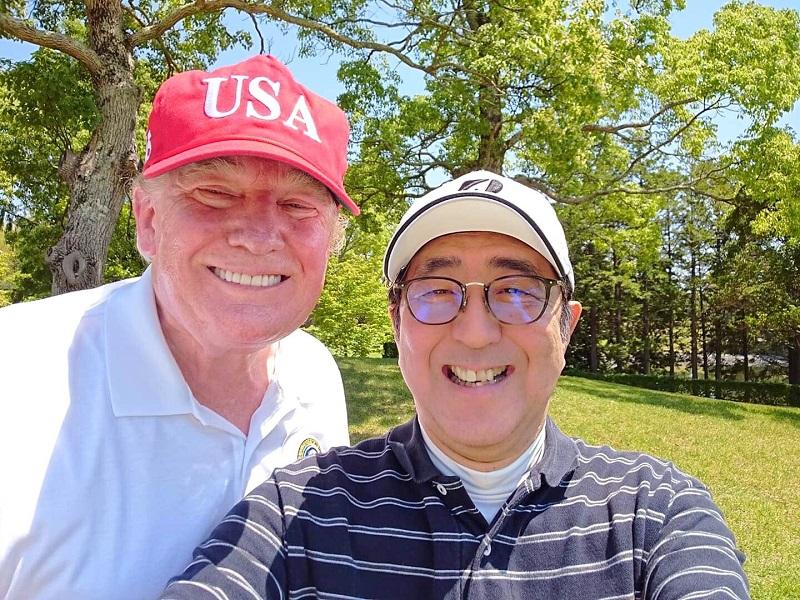
What do French President Emmanuel Macron and Japanese Prime Minister Shinzo Abe have in common? For one thing, they both believe that, by stroking US President Donald Trump’s fragile ego, they can coax him into maintaining the traditional alliances that he has proved all too willing to abandon. But, while America’s narcissist-in-chief is undoubtedly susceptible to flattery, there are limits to this approach.
Macron is already learning this. The ‘friendship tree’ that he gave Trump last year—which the leaders and their wives planted in the White House lawn—is now dead. It’s an apt metaphor.
But Abe’s charm offensive is still in full swing. The first world leader to meet with Trump after his election victory in 2016, Abe returned to Washington in April. The next month, Trump was in Japan, where Abe pulled out all the stops.
Trump presented to a sumo wrestling champion the ‘United States President’s Cup’, a 137-centimetre trophy that was made up for the occasion. He also became the first foreign leader to be received by Emperor Naruhito. He was, in his own boastful words, ‘the guest of honor at the biggest event that they’ve had in over 200 years’.
Abe has reportedly nominated Trump for a Nobel Peace Prize—at the request of the US—for opening talks with North Korea. And he has offered to mediate in America’s dispute with Iran. (Abe’s recent visit to Tehran—where he reportedly asked Iran’s leaders, at Trump’s request, to release detained Americans—made clear that, even squeezed by sanctions, Iran has no interest in negotiating with a serial violator of signed agreements.)
What Trump calls an ‘incredible partnership’ is, in reality, a largely one-sided relationship. But, for Abe, appeasing Trump is not so much a choice as a necessity: he must prove to Japan’s people and their neighbours, particularly the Chinese, that he knows how to keep Trump on his side.
The problem is that, no matter how hard Abe tries—no matter how many complimentary words are spoken or friendship displays are photographed—the US and Japan remain divided on the same issues as always: North Korea, trade and the reliability of US security guarantees in Asia.
On North Korea, Trump reacts assertively to tests of long-range missiles, which could reach the US mainland, but has declared that he is ‘personally’ unbothered by tests of short-range missiles, which could reach Japan. In contrast not only to Abe, but also to his own national security adviser, John Bolton, and former acting defence secretary, Patrick Shanahan, Trump refused to acknowledge that the short-range tests violated United Nations Security Council resolutions banning all ballistic missiles. ‘Perhaps [Kim Jong-un] wants to get attention, and perhaps not’, Trump said flippantly. ‘Who knows? It doesn’t matter.’
America’s withdrawal from the Middle East, after opening the way for Russia to gain a foothold in the region, has only intensified Japan’s fears for its own security, and not just with regard to North Korea. China—the world’s second-largest economy and home to 20% of the world’s population—may be a vital trading partner for its neighbours, but its aggressive, destabilising and largely unchecked actions in the East and South China Seas raise serious risks for the region.
Abe is well aware of Japan’s vulnerability. For years, he has been pushing to amend Japan’s pacifist constitution to expand the mandate of the country’s self-defence forces. In the meantime, Japan plans to spend US$245 billion—1% of its GDP—on defence over the next five years, more than France or the United Kingdom.
But, of course, that investment won’t put Japan in any position to confront China, whose defence budget is more than four times larger. That leaves Japan with little choice but to keep trying to improve the odds that the US will uphold its commitments.
Unsurprisingly, Trump has made no concessions on trade either. On the contrary, he complains that the US has an ‘unbelievably large’ trade deficit with Japan, and has threatened—invoking national security concerns—to raise tariffs on US imports of Japanese automobiles.
Such a move would hurt Japan far more than the steel and aluminium tariffs Trump imposed last year; in fact, it would probably send Japan into recession. Such an outcome would be all the more likely in view of the Trump administration’s pushback against the Bank of Japan’s stimulatory monetary policies, which it insists are unfairly driving down the yen’s value.
Japan’s plans to purchase 105 F-35 fighter jets will go some way towards reducing Japan’s trade surplus with the US and may help to persuade Trump not to follow through with the auto tariffs. But the truth, as Japanese Finance Minister Taro Aso recently observed, is that as long as the US doesn’t produce the goods it consumes at competitive prices, tariffs on one country will merely shift its deficit to other trading partners.
For Trump, however, tariffs aren’t logical. Rather, they are a knee-jerk reaction to any disagreement or challenge. Nowhere is that more apparent than in his threats to slap tariffs on US imports from Mexico, unless the country’s government curbs illegal immigration to the US—a move so reckless that even Senate Republicans, who have been all too willing to fall in line behind Trump, publicly oppose it.
Trump did make one small concession to Abe: a trade deal will be reached only after Japan’s parliamentary elections next month. But while that may ease pressure on Abe in the immediate term, it’s cold comfort coming from a US administration as fickle and self-serving as Trump’s.